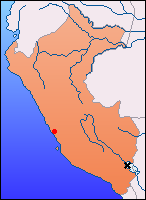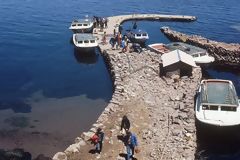 |
Associated pages: |
 Located about 35 kilometers from Puno, in the heart of the majestic Lake Titicaca, the island of Taquile presents itself as a true oasis of peace. At first glance, it seems like a place out of time: no roads, no hotels, no cars, and not even electricity. On this dream island, life follows the rhythm of nature and ancient traditions. To reach Taquile, the boat trip takes approximately three hours from Puno, and visitors must be prepared for the relentless sun that dominates the crossing.
Located about 35 kilometers from Puno, in the heart of the majestic Lake Titicaca, the island of Taquile presents itself as a true oasis of peace. At first glance, it seems like a place out of time: no roads, no hotels, no cars, and not even electricity. On this dream island, life follows the rhythm of nature and ancient traditions. To reach Taquile, the boat trip takes approximately three hours from Puno, and visitors must be prepared for the relentless sun that dominates the crossing.
The island is about 7 kilometers wide at its broadest point, which means that despite its small size, there is much to explore. Visiting the island in a single day can be exhausting, though incredibly enriching. The round-trip boat journey takes around six hours in total, and upon arrival, visitors are met with the famous 533 steps that must be climbed to reach the main village. Additionally, the altitude of more than 3,800 meters above sea level adds an extra challenge for those unaccustomed to such heights.
Taquile is known not only for its natural beauty but also for its deep sense of community and the preservation of its ancestral traditions. The pre-Inca terraces that dominate the landscape are a testament to an ancient civilization that learned to adapt the land for agriculture under harsh conditions. Though small, the ruins scattered across the island tell the story of a people who lived in harmony with their environment.
The community, composed of about 1,200 inhabitants, is warm and maintains a way of life that has changed little over the centuries. The Taquileños wear traditional clothing, and the primary language spoken is Quechua, though many also understand Spanish. The island is famous for its high cultural and ethnic value, and it has managed to preserve its customs despite the growing influx of tourists.
One of the islanders' greatest prides is their textile craftsmanship. Taquile’s handicrafts are globally recognized for their quality, and the men of the community are the main weavers. The textiles produced on Taquile are not only beautiful but also tell stories and represent important symbols of the local culture. Weaving is an activity practiced by both men and women, and each garment carries a special meaning. For example, the hat worn by men can indicate their marital status: a hat with a white tip means that the man is single.
Life on Taquile follows a communal model where all the inhabitants work together. The land is farmed collectively, and the crops are distributed according to the needs of each family. This strong social cohesion has allowed the Taquileños to resist external changes and continue living according to their centuries-old traditions. For tourists who choose to spend the night on the island, local families offer accommodation in their homes, providing an authentic and enriching experience.
Tourism has reached Taquile, but it has done so slowly and in a controlled manner. Unlike other tourist destinations, here you won’t find large hotels or luxury restaurants. Instead, visitors can enjoy the hospitality of local families and simple yet delicious meals made with fresh ingredients from the region. The island's improvised restaurants offer whatever is available that day: if you’re lucky, you may enjoy fresh trout, but sometimes the menu may consist of nothing more than boiled potatoes.
Taquile remains one of the few places in the world where tourism has not significantly transformed the lives of its inhabitants. The Taquileños have managed to maintain a balance between opening up to the outside world and preserving their cultural identity. Although more and more tourists visit the island each year, their impact has remained minimal, and the community continues to operate according to its traditional principles.
If you decide to visit Taquile, it’s important to be prepared for physical exertion. The combination of altitude, climate, and long walks can be challenging for some. Bringing sunscreen, a hat, and plenty of water is essential, as the sun can be very intense at this altitude. Comfortable footwear is also recommended, as most of the island's exploration is done on foot. Finally, for those seeking a more immersive experience, spending the night on the island allows you to fully appreciate its tranquility and beauty without being rushed.